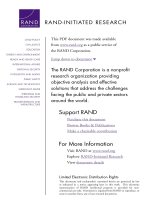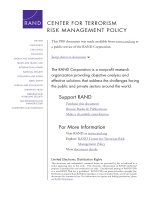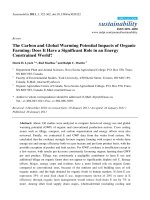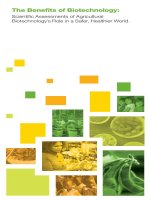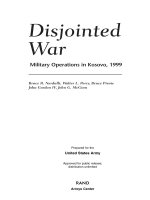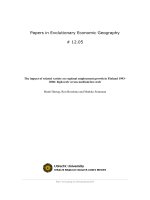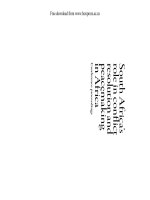- Trang chủ >>
- Y - Dược >>
- Truyền nhiễm
Limited role in antibiotics in covid 19
Bạn đang xem bản rút gọn của tài liệu. Xem và tải ngay bản đầy đủ của tài liệu tại đây (1.5 MB, 23 trang )
The Lancet Infectious Diseases
Limited Role for Antibiotics in COVID-19: Scarce Evidence of Bacterial Coinfection
--Manuscript Draft-Manuscript Number:
THELANCETID-D-20-04123
Article Type:
Article (Original Research)
Keywords:
Coinfection; COVID-19; SARS-CoV-2; antimicrobial stewardship; communityacquired pneumonia
Corresponding Author:
Wenjing Wei, PharmD
Parkland Health and Hospital System
Dallas, TX UNITED STATES
First Author:
Wenjing Wei, PharmD
Order of Authors:
Wenjing Wei, PharmD
Jessica K. Ortwine, PharmD
Norman S. Mang, PharmD
Christopher Joseph, BA
Brenton C. Hall, PharmD
Bonnie C. Prokesch, MD
Manuscript Region of Origin:
UNITED STATES
Abstract:
Background
There is currently a paucity of data describing bacterial coinfections, related antibiotic
prescribing patterns, and the potential role of antimicrobial stewardship in the care of
patients infected with SARS-CoV-2.
Methods
This prospective, observational study was conducted from March 10, 2020 to April 21,
2020 in admitted patients with confirmed COVID-19. Patients were included if ≥ 18
years old and admitted to the hospital for further treatment. Data was collected via
chart review from the enterprise electronic health record database. Data collected
include factors driving antibiotic choice, indication, and duration of therapy as well as
microbiological data.
Findings
Antibiotics were initiated on admission in 87/147 (59%) patients. Of these, 85/87 (98%)
prescriptions were empiric. The most common indication for empiric antibiotics was
concern for community-acquired pneumonia (76/85, 89%) with the most prescribed
antibiotics being ceftriaxone and azithromycin. The median duration of antibiotic
therapy was two days (interquartile range 1-5). No patients had a community-acquired
bacterial respiratory coinfection, but 10/147 (7%) of patients were found to have
concurrent bacterial infections from a non-respiratory source, and one patient was
diagnosed with active pulmonary tuberculosis at the time of admission for COVID-19.
Interpretation
Bacterial coinfection in patients with COVID-19 was infrequent. Antibiotics are likely
unnecessary in patients with mild symptoms. There is little role for broad-spectrum
antibiotics to empirically treat multidrug resistant organisms in patients with COVID-19,
regardless of disease severity. Antimicrobial stewardship remains important in patients
infected with SARS-CoV-2.
Powered by Editorial Manager® and ProduXion Manager® from Aries Systems Corporation
This preprint research paper has not been peer reviewed. Electronic copy available at: />
Manuscript
Limited Role for Antibiotics in COVID-19: Scarce Evidence of Bacterial Coinfection
Wenjing Wei, PharmD1,2, Jessica K. Ortwine, PharmD1,2, Norman S. Mang, PharmD1,2, Christopher Joseph, BA3,
Brenton C. Hall, PharmD1, Bonnie C. Prokesch, MD2
1
Department of Pharmacy, Parkland Health & Hospital System, Dallas, TX, USA; 2Department of Internal
Medicine, Division of Infectious Diseases, University of Texas Southwestern Medical Center, Dallas, TX, USA;
3
University of Texas Southwestern Medical School, Dallas, TX, USA
Key words: Coinfection, COVID-19, SARS-CoV-2, antimicrobial stewardship, community-acquired pneumonia
Corresponding Author:
Wenjing Wei, PharmD
Parkland Health & Hospital System
5200 Harry Hines Blvd, Dallas, TX 75235
Phone: 469-419-1808
Email:
Alternate Corresponding Author:
Bonnie C. Prokesch, MD
University of Texas Southwestern Medical Center
5323 Harry Hines Blvd, Dallas, TX 75390
Phone: 241-648-8806
Email:
1
This preprint research paper has not been peer reviewed. Electronic copy available at: />
Abstract
Background:
There is currently a paucity of data describing bacterial coinfections, related antibiotic prescribing patterns, and the
potential role of antimicrobial stewardship in the care of patients infected with SARS-CoV-2.
Methods:
This prospective, observational study was conducted from March 10, 2020 to April 21, 2020 in admitted patients
with confirmed COVID-19. Patients were included if ≥ 18 years old and admitted to the hospital for further
treatment. Data was collected via chart review from the enterprise electronic health record database. Data collected
include factors driving antibiotic choice, indication, and duration of therapy as well as microbiological data.
Findings:
Antibiotics were initiated on admission in 87/147 (59%) patients. Of these, 85/87 (98%) prescriptions were empiric.
The most common indication for empiric antibiotics was concern for community-acquired pneumonia (76/85, 89%)
with the most prescribed antibiotics being ceftriaxone and azithromycin. The median duration of antibiotic therapy
was two days (interquartile range 1-5). No patients had a community-acquired bacterial respiratory coinfection, but
10/147 (7%) of patients were found to have concurrent bacterial infections from a non-respiratory source, and one
patient was diagnosed with active pulmonary tuberculosis at the time of admission for COVID-19.
Interpretation:
Bacterial coinfection in patients with COVID-19 was infrequent. Antibiotics are likely unnecessary in patients with
mild symptoms. There is little role for broad-spectrum antibiotics to empirically treat multidrug resistant organisms
in patients with COVID-19, regardless of disease severity. Antimicrobial stewardship remains important in patients
infected with SARS-CoV-2.
Funding:
The authors received no funding for this work.
2
This preprint research paper has not been peer reviewed. Electronic copy available at: />
Introduction:
In December 2019, a novel coronavirus, severe acute respiratory syndrome coronavirus 2 (SARS-CoV-2) was first
detected in Wuhan, China and found to cause acute respiratory symptoms and pneumonia. The disease caused by
SARS-CoV-2 was named coronavirus disease 2019 (COVID-19). SARS-CoV-2 has led to a global pandemic
affecting over 200 countries.1 In the United States, cases continue to increase with over one million confirmed
infections and 73,000 associated deaths as of May 2020.2
Patients with COVID-19 present with a variety of signs and symptoms but the majority exhibit fever, dry cough, and
fatigue. Many patients also experience shortness of breath, myalgias, and anorexia amongst other less common
symptoms. Disease severity can range from asymptomatic or relatively mild to severe with an estimated 20% of
patients requiring admission to an intensive care unit (ICU).3 Chest imaging of patients with COVID-19 typically
reveals bilateral multi-focal opacities on plain radiographs and bilateral, peripheral interstitial ground glass opacities
on computerized tomography (CT).2,3 These findings are nonspecific and overlap with other infectious etiologies,
creating uncertainty in differentiating COVID-19 from other common viral or bacterial respiratory infections. Thus,
if bacterial pneumonia or sepsis is strongly suspected, initiation of empiric antibiotics to cover for communityacquired pneumonia (CAP) has been recommended by national guidelines.3,4
Bacterial infections occur both concomitantly and subsequent to a variety of viral respiratory illnesses. In the preantibiotic era of the 1918 influenza pandemic, bacterial infections complicated nearly all influenza-related deaths.
More recently during the 2009 influenza A (H1N1) pandemic, bacterial infections were identified in up to 34% of
ICU managed patients.5 In a typical, non-pandemic influenza season, nearly 20% of patients are diagnosed with
community-acquired bacterial infections, most commonly caused by Staphylococcus aureus and Streptococcus
pneumoniae.5,6 However, there is currently a paucity of data describing bacterial infections and related antibiotic
prescribing in patients with COVID-19.
The continued development of antimicrobial resistance globally may be exacerbated in the setting of an infectious
pandemic. Thus, in light of the rising number of COVID-19 cases worldwide, we believe that it is of utmost
importance to continue promoting the judicious use of anti-infective agents and highlight the role of antimicrobial
stewardship. The goal of this study is to assess how often patients with SARS-CoV-2 infection have clear evidence
of concurrent bacterial infections and to better characterize the factors driving antibiotic prescribing, selection, and
duration of therapy in this cohort of patients. This information is critical to defining the role of antimicrobial
3
This preprint research paper has not been peer reviewed. Electronic copy available at: />
stewardship in assisting with antibiotic de-escalation and discontinuation in the management of patients with
COVID-19.
Methods:
Study design and participants
This prospective, observational study was conducted at Parkland Health & Hospital System and included patients
admitted between March 10, 2020 and April 21, 2020. Parkland is an 862-bed safety net hospital as well as the
primary teaching site for the University of Texas Southwestern (UTSW) Medical School providing care to
underserved residents of Dallas County in Dallas, Texas and averages over one million patient visits annually. The
study was approved by the UTSW Medical Center institutional review board and informed consent was waived.
Patients were included if they tested positive for SARS-CoV-2 by polymerase chain reaction (PCR), were 18 years
of age or older, and were admitted to the hospital for management of COVID-19. Patients were excluded if the index
admission for COVID-19 was at an outside facility.
Data collection
Patient charts were retrospectively reviewed and data was collected from the enterprise electronic health record
database by the primary investigator and study personnel. Baseline characteristics collected include demographic
information, significant comorbidities, smoking history, history of intravenous (IV) antibiotic exposure in the 90
days prior to admission, and COVID-19 disease severity. In addition, data regarding fever, white blood cell (WBC)
count, oxygen requirement, pulmonary imaging findings, pathogen-directed infectious work up, requirement of
mechanical ventilation, vasopressors, continuous renal replacement therapy, length of stay, infection with
Clostridioides difficile during admission, and in-hospital mortality related to COVID-19 were collected. Antibiotics
initiated within 48 hours of admission were recorded along with rationale, therapeutic indication, and duration of
use. Antibiotics that were initiated greater than 48 hours after time of admission were considered treatment for a
possible secondary bacterial infection, rather than coinfection upon admission, and thus were excluded. Clinical data
and outcomes were monitored through June 1st,, 2020.
Laboratory procedures
From March 10, 2020 to March 27, 2020, patients were confirmed to have SARS-CoV-2 via PCR testing on
nasopharyngeal and oropharyngeal samples through outside testing facilities. On March 27, 2020, Parkland
4
This preprint research paper has not been peer reviewed. Electronic copy available at: />
instituted in-house PCR testing on nasopharyngeal samples via the Xpert Xpress SARS-CoV-2 test manufactured by
Cepheid®. Influenza/respiratory syncytial virus (RSV) PCR as well as a composite respiratory pathogen PCR panel
were performed using nasopharyngeal samples. Other infectious work-up included Legionella urinary antigen
testing and methicillin-resistant Staphylococcus aureus (MRSA) surveillance collected from the nares.
Outcomes
Patients who received antibiotics on admission were compared to those who did not in order to characterize the
factors driving antimicrobial prescribing in patients presenting with COVID-19. In addition, patients were assessed
for evidence of community-acquired bacterial respiratory coinfection (CABRC) as well as concurrent bacterial
infections from a non-respiratory source on admission.
Definitions
The severity of COVID-19 was defined using an institution-specific management algorithm (See Supplementary
Material). Fever was defined as greater than 100·4 °F (38 °C). Leukopenia and leukocytosis were defined as a WBC
count less than 4,000 cells/μL or greater than 11,000 cells/μL, respectively. CABRC was defined as presence of a
positive bacterial culture consistent with CAP within 48 hours of admission and clinical signs and symptoms
consistent with CAP as documented by the treatment team. Concurrent bacterial infection was defined as a positive
non-respiratory bacterial culture within 48 hours of admission plus documentation consistent with active infection.
Statistical analysis
Continuous measurements were presented as means and standard deviations (SD) or medians and interquartile
ranges (IQR) and evaluated using Student’s t-test, or Mann-Whitney U test, respectively. Categorical variables were
presented as counts (%) and evaluated using a χ2 test or Fisher’s exact test.
Role of funding source
This study had no funder. The corresponding author had full access to all the data in the study and had final
responsibility for the decision to submit for publication.
Results:
A total of 151 patients met inclusion criteria with 147 ultimately included in the study. Four patients were excluded
due to having their index admission for COVID-19 at an outside facility. The average age of patients was 52 years
and 60/147 (41%) were female (Table 1). One or more comorbidities were found in 114/147 patients (78%), with 16
5
This preprint research paper has not been peer reviewed. Electronic copy available at: />
patients (11%) having underlying chronic lung disease and 21 patients (14%) reporting being active cigarette
smokers. Patients were admitted to the hospital after experiencing a median of 5 days (interquartile range, 3 to 7) of
symptoms with the majority presenting with moderate severity COVID-19 disease (109/147, 74%). Seventeen
patients (12%) met the criteria for severe COVID-19 with 10 (7%) requiring either mechanical ventilation or
vasopressor support on admission.
Antibiotics were initiated within 48 hours of admission in 87/147 patients (59%). Of these, 85 patients (98%)
received antibiotics as empiric therapy, and 2 (2%) had antibiotics continued from an outpatient course. The most
common indication for empiric antibiotics (Table 2) was CAP (76/85, 89%). The median duration of antibiotic
therapy for any indication was 2 days (interquartile range, 1 to 5). Following the introduction of in-house PCR
testing for SARS-CoV-2, a shorter duration of antibiotic therapy was noted (Figure 1). The majority of patients
(74/85, 87%) were exposed to two or more antibiotics during the empiric course of therapy, most commonly
ceftriaxone and azithromycin (Table 3). Broad-spectrum antibiotic therapy (vancomycin, piperacillin/tazobactam,
and/or cefepime) was prescribed in only 24/147 (16%) patients. Of these 24 patients, only four patients had a recent
history of IV antibiotic exposure in the 90 days prior to admission and none had a history of MRSA or Pseudomonas
aeruginosa.
Antibiotic prescribing was significantly more common in patients with severe disease, evidence of pneumonia on
imaging, leukocytosis, or supplemental oxygen requirements on admission. Patients who presented with mild
disease were significantly less likely to receive antibiotics. There was no difference in frequency of antibiotic
prescribing in patients with moderate disease or in those who were febrile on admission. Patients initiated on
antibiotics upon admission also underwent a significantly more robust infectious workup than those who were not
started on empiric antibiotic therapy (Table 1).
While respiratory cultures were ordered on 47/147 (32%) patients, none returned positive for significant bacterial
growth. All Legionella urine antigen tests were negative. Most patients had blood cultures drawn on admission
(112/147 [76%]), including all 24 patients who were started on broad-spectrum antibiotics. In addition, 45/147
(31%) had urine cultures sent and 19/147 (13%) were screened for MRSA nares colonization. No proven CABRCs
6
This preprint research paper has not been peer reviewed. Electronic copy available at: />
were identified in our patient cohort. However, clinical suspicion remained high enough that 19/76 (25%) patients
who received empiric antibiotics for CAP on admission completed at least five days of therapy. Overall, 10/147
(7%) of patients were found to have concurrent bacterial infections unrelated to a respiratory source and one patient
was diagnosed with active pulmonary tuberculosis (Table 4). Although nine patients were found to have positive
blood cultures on admission, eight cultures were deemed contaminants (see Supplementary Material). One patient
was considered to have a veritable bacteremia which was secondary to a gastrointestinal source. Similarly, ten
patients had positive urine cultures on admission, but only five were considered pathogenic per treatment team
documentation.
Discussion:
Early epidemiological studies of patients with COVID-19 reported empiric antibiotic use in 71-100% of patients,
with Chen and colleagues reporting a median duration of therapy of five days (interquartile range, 3 to 7).7–11
Comparatively, we found lower rates of empiric antibiotic utilization with shorter durations of therapy overall.
Longer durations of therapy were noted earlier in the outbreak and may be correlated with lengthy turnaround times
(more than one week) to receive final SARS-CoV-2 testing results from a commercial reference laboratory. Once inhouse testing was established, turnaround times decreased dramatically with results typically available to clinicians
within two hours. This likely contributed to increased levels of physician comfort in withholding empiric antibiotics
in more stable patients given the prompt return of diagnostic testing, as well as facilitating more rapid antibiotic deescalation in those patients testing positive for COVID-19. The availability of rapid on-site testing for SARS-CoV-2
plays an important role in the decision-making process for discontinuation of antibiotic therapy.
Antibiotic choice was not reported in most prior studies published on this topic, but empiric agents primarily
targeted common CAP pathogens. Wang and colleagues reviewed antibiotic use among 102 patients with COVID19 and observed 87 (85%) patients received quinolones, 34 (33%) cephalosporins, and 25 (25%) carbapenems,
while Cao and colleagues reported receipt of moxifloxacin in 39/67 (58%) patients and antifungal therapy in 8/67
(12%).11,12 Unlike previously published literature which showed a high use of quinolones and carbapenems, we
observed more narrow-spectrum antibiotic utilization. This is consistent with the 2019 American Thoracic
Society/Infectious Diseases Society of America (ATS/IDSA) practice guidelines for CAP, which recommend
7
This preprint research paper has not been peer reviewed. Electronic copy available at: />
combination therapy with an IV beta-lactam (e.g. ceftriaxone) plus azithromycin for patients admitted with CAP in
the absence of risk factors for infections caused by multi-drug resistant organisms.13
We observed limited use of broad-spectrum agents in general, though that may be because this study focused only
on antibiotics prescribed within 48 hours of hospital admission. The ATS/IDSA CAP guidelines recommend
empirically treating MRSA or Pseudomonas aeruginosa only if specific risk factors are present. These risk factors
include recent hospitalization with receipt of IV antibiotics, prior history of either pathogen in the last 12 months, or
high local prevalence rates for either pathogen.13 Only four patients in this study had risk factors for multi-drug
resistant (MDR) organisms, and therefore the majority of patients were appropriately prescribed narrow-spectrum
antibiotics. Most of the patients initiated on broad-spectrum regimens were de-escalated quickly if MRSA
surveillance screen and/or blood cultures were negative. Based on these observations, we recommend that careful
assessment of MDR risk factors be performed before initiating broad-spectrum antibiotics and cultures should be
obtained to help guide de-escalation. MRSA nasal screening has a negative predictive value of > 95% for MRSA
pneumonia. The utilization of MRSA surveillance screening to assist with early de-escalation should be encouraged
in order to decrease unnecessary exposure to vancomycin, lab draws and monitoring, and reduce risk of
nephrotoxicity.14,15
There is currently limited information available regarding rates of bacterial coinfections with COVID-19. However,
bacterial coinfection rates of 0-47% and 2-65% were reported in systematic reviews of pandemic influenza H1N1
and of influenza and other respiratory viruses, respectively.16,17 While S. pneumoniae was the most commonly
identified organism, MRSA and nosocomial Gram-negative organisms were also reported. Differences in illness
severity, timing of infection, and whether coinfection was documented on admission or resulted as a complication of
prolonged hospital stay, mechanical ventilation, or secondary to the virus may have contributed to the variability in
reported rates. In a prospective analysis of CAP by Abelenda-Alonso and colleagues only 57/1123 (5·1%) patients
had influenza and a bacterial coinfection on admission, which is similar to the minimal evidence of coinfection in
our study.18 Because COVID-19 has emerged recently, there is limited literature regarding bacterial coinfections in
the setting of primary SARS-CoV-2 infection, but a review of 18 studies describing bacterial coinfections in patients
with any coronavirus infection was performed by Rawson and colleagues.19 The authors described low rates of
bacterial coinfection among the nine studies published for COVID-19 (62/806 [8%]). However, most studies were
not specifically evaluating coinfections and thus did not report the organisms identified. The low rates of bacterial
8
This preprint research paper has not been peer reviewed. Electronic copy available at: />
coinfections among patients with respiratory viral illnesses, including COVID-19, are similar to the findings in our
cohort of 147 patients. Interestingly, the average time to development of a bacterial superinfection in patients with
influenza has been reported to be 7-14 days after the onset of the viral infection.20 Therefore, the fact that none of
the patients in our cohort were found to have definitive evidence of bacterial coinfection on admission is not
unusual, as the patients presented a median of five days from symptom onset.
The median duration of antibiotic therapy in our cohort was short, indicating that suspicion for bacterial coinfection
was low with only 19/147 (13%) patients receiving five days or more of empiric antibiotic therapy for CAP. Due to
concern for increased infection transmission, most respiratory samples were collected from throat swabs rather than
sputum or lower respiratory tract samples and half of the samples obtained from sputum were rejected due to being
unsatisfactory quality specimens. Although identification of organisms may have been limited by this inability to
obtain quality respiratory cultures, sputum cultures overall have poor yield for pathogen isolation. Our institution
does not perform S. pneumoniae urine antigen testing; however, both S. pneumoniae and Legionella urine antigen
tests have modest sensitivity for clinical disease and the most recent ATS/IDSA CAP guidelines do not recommend
routinely testing these urine antigens in adults with non-severe CAP.14 Procalcitonin has been suggested as a
potentially useful biomarker to differentiate bacterial and viral infections and assist with antibiotic decisionmaking.21–23 However, due to the lack of data regarding its reliability in completely ruling out bacterial pneumonia
with accuracy, the role of procalcitonin in COVID-19 is currently unknown.13,24 Although blood cultures are not
routinely recommended in non-severe CAP, they were collected from a majority of patients in this cohort. Blood
culture results were ultimately not helpful in identifying clinically significant pathogens as nearly all organismal
growth was considered to be from skin contamination. Therefore, blood cultures are likely not necessary in patients
presenting with mild to moderate COVID-19 who do not meet the criteria for severe CAP.
In summary, we identified zero cases of CABRC in patients with COVID-19. While it is reasonable to initiate
empiric antibiotics for possible bacterial infection in clinically severe patients awaiting diagnostic confirmation of
COVID-19, broad-spectrum agents are likely unnecessary in the absence of risk factors for MDR organisms. Based
on this study, it appears antibiotics are of limited utility in the setting of proven COVID pneumonia. If antibiotics
are initiated, they should be de-escalated early in patients positive for SARS-CoV-2 with no other evidence of
bacterial infection within 48 hours. Antimicrobial stewardship has an important role in limiting unnecessary
antibiotic exposure and optimizing resources during this COVID pandemic.
9
This preprint research paper has not been peer reviewed. Electronic copy available at: />
Contributors
WW, JKO, NSM, and BCP conceived and designed the study. WW and CJ performed the data collection. WW and
BCH performed data analysis. WW drafted the manuscript and all authors participated in critical revision of the
manuscript for important intellectual content. All authors approved the final manuscript and were responsible for the
decision to submit for publication.
Declaration of Interests: The authors report no relevant conflicts of interest.
References:
1.
Coronavirus (COVID-19) pandemic [Internet]. World Health Organization. [cited 2020 May 1]; Available
from: />
2.
Coronavirus (COVID-19) [Internet]. Center for Disease Control and Prevention. [cited 2020 May 1];
Available from: />
3.
COVID-19 treatment guidelines panel. Coronavirus disease 2019 (COVID-19) treatment guidelines
[Internet].
National
Institutes
of
Health.
[cited
2020
May
13];
Available
from:
.
4.
Alhazzani W, Møller MH, Arabi YM, et al. Surviving sepsis campaign: guidelines on the management of
critically ill adults with coronavirus disease 2019 (COVID-19). Crit Care Med 2020; 48:e440–69.
5.
Chertow DS, Memoli MJ. Bacterial coinfection in influenza: a grand rounds review. JAMA 2013; 309:275–
82.
6.
Teng F, Liu X, Guo S, et al. Community-acquired bacterial co-infection predicts severity and mortality in
influenza-associated pneumonia admitted patients. J Infect Chemother 2019; 12:129–36.
7.
Lupia T, Scabini S, Mornese Pinna S, Di Perri G, De Rosa FG, Corcione S. 2019 Novel coronavirus (2019nCoV) outbreak: a new challenge. J Glob Antimicrob Resist 2020; 21:22–7.
10
This preprint research paper has not been peer reviewed. Electronic copy available at: />
8.
Huang C, Wang Y, Li X, et al. Clinical features of patients infected with 2019 novel coronavirus in Wuhan,
China. Lancet 2020; 395:497–506.
9.
Chen N, Zhou M, Dong X et al. Epidemiological and clinical characteristics of 99 cases of 2019 novel
coronavirus pneumonia in Wuhan, China: a descriptive study. Lancet 2020; 395:507–13.
10. Zhou F, Yu T, Du R, et al. Clinical course and risk factors for mortality of adult inpatients with COVID-19
in Wuhan, China: a retrospective cohort study. Lancet 2020; 395:1054–62.
11. Wang Z, Yang B, Li Q, Wen L, Zhang R. Clinical features of 69 cases with coronavirus disease 2019 in
Wuhan, China. Clin Infect Dis 2020 [Epub ahead of print].
12. Cao J, Tu W, Cheng W, et al. Clinical features and short-term outcomes of 102 patients with corona virus
disease 2019 in Wuhan, China. Clin Infect Dis 2020 [Epub ahead of print].
13. Metlay JP, Waterer GW, Long AC, et al. Diagnosis and treatment of adults with community-acquired
pneumonia: an official clinical practice guideline of the American Thoracic Society and Infectious Diseases
Society of America. Am J Resp Crit Care Med 2019; 200:e45–67.
14. Dangerfield B, Chung A, Webb B, Seville MT. Predictive value of methicillin-resistant Staphylococcus
aureus (MRSA) nasal swab PCR assay for MRSA pneumonia. Antimicrob Agents Chemother 2014;
58:859–64.
15. Tilahun B, Faust AC, McCorstin P, Ortegon A. Nasal colonization and lower respiratory tract infections
with methicillin-resistant Staphylococcus aureus. Am J Crit Care 2015; 24:8–12.
16. MacIntyre CR, Chughtai AA, Barnes M, et al. The role of pneumonia and secondary bacterial infection in
fatal and serious outcomes of pandemic influenza a(H1N1)pdm09. BMC Infect Dis 2018; 18:637.
17. Klein EY, Monteforte B, Gupta A, et al. The frequency of influenza and bacterial coinfection: a systematic
review and meta-analysis. Influenza and Other Respir Viruses 2016; 10:394–403.
18. Abelenda-Alonso G, Rombauts A, Gudiol C, et al. Influenza and bacterial coinfection in adults with
community-acquired pneumonia admitted to conventional wards: risk factors, clinical features, and
outcomes. Open Forum Infect Dis 2020; 7:ofaa066.
19. Rawson TM, Moore LSP, Zhu N, et al. Bacterial and fungal co-infection in individuals with coronavirus: A
rapid review to support COVID-19 antimicrobial prescribing. Clin Infect Dis 2020 [Epub ahead of print].
11
This preprint research paper has not been peer reviewed. Electronic copy available at: />
20. Paget C, Trottein F. Mechanisms of bacterial superinfection post-influenza: a role for unconventional T
cells. Front Immunol 2019; 10:336.
21. Cuquemelle E, Soulis F, Villers D, et al. Can procalcitonin help identify associated bacterial infection in
patients with severe influenza pneumonia? A multicentre study. Intensive Care Med 2011; 37:796–800.
22. Rodriguez AH, Aviles-Jurado FX, Diaz E, et al. Procalcitonin (PCT) levels for ruling-out bacterial
coinfection in ICU patients with influenza: a CHAID decision-tree analysis. J Infect 2016; 72:143–51.
23. Pfister R, Kochanek M, Leygeber T, et al. Procalcitonin for diagnosis of bacterial pneumonia in critically
ill patients during 2009 H1N1 influenza pandemic: a prospective cohort study, systematic review and
individual patient data meta-analysis. Crit Care 2014; 18:R44.
24. Lippi G, Plebani M. Procalcitonin in patients with severe coronavirus disease 2019 (COVID-19): a metaanalysis. Clin Chim Acta 2020; 505:190–1.
12
This preprint research paper has not been peer reviewed. Electronic copy available at: />
Table + Figure
Table 1. Clinical Characteristics of Patients and Relation to Antibiotic Prescribing
Total
Antibiotic
No Antibiotic
(N=147)
(N=87)
(N=60)
Age, years
52 (18)
53 (18)
48 (15)
0·015
Female sex
60 (41)
34 (39)
26 (43)
0·606
None
33 (22)
23 (26)
10 (16)
0·231
Chronic lung disease
16 (11)
9 (10)
7 (12)
0·800
Hypertension
63 (43)
37 (43)
26 (43)
0·923
Diabetes
48 (33)
25 (29)
23 (38)
0·223
Hyperlipidemia
35 (24)
19 (22)
16 (27)
0·499
Chronic kidney disease/ESRD
14 (10)
7 (8)
7 (12)
0·462
Active cancer
9 (6)
8 (9)
1 (2)
0·083
Congestive heart failure
9 (6)
3 (3)
6 (10)
0·160
Coronary heart disease
8 (5)
5 (6)
3 (5)
1·000
HIV
5 (3)
3 (3)
2 (3)
1·000
Cirrhosis
2 (1)
1 (1)
1 (2)
1·000
21 (14)
12 (14)
9 (15)
0·837
4 (3)
4 (5)
0 (0)
0·145
Mild
21 (14)
5 (6)
16 (27)
0·00037
Moderate
109 (74)
65 (75)
43 (73)
0·681
Severe
17 (12)
17 (20)
0(0)
0·00027
Pneumonia on imaging
124 (84)
79 (91)
45 (75)
0·010
Fever on admission
105 (71)
66 (76)
39 (65)
0·152
Fever > 3 days
71 (48)
45 (52)
26 (43)
0·317
Leukopenia
20 (14)
10 (11)
10 (17)
0·369
Leukocytosis
12 (8)
12 (14)
0 (0)
0·004
Supplemental oxygenation
80 (54)
55 (63)
25 (42)
0·010
22 (15)
4 (5)
18 (30)
<0·0001
Characteristic
P-value
Comorbidities
Active smoker
IV antibiotics in the last 90 days
COVID-19 disease severity
Presentation
Infectious labs ordered
None
This preprint research paper has not been peer reviewed. Electronic copy available at: />
Influenza/RSV
39 (27)
33 (38)
6 (10)
0·00016
Respiratory viral panela
36 (24)
30 (34)
6 (10)
0·00069
Legionella urine antigen
51 (35)
41 (47)
10 (17)
0·00014
Respiratory culture
47 (32)
36 (41)
11 (18)
0·0032
Blood culture
112 (76)
77 (89)
35 (58)
< 0·0001
Urine culture
45 (31)
31 (36)
14 (23)
0·112
MRSA nares screen
19 (13)
18 (21)
1 (2)
0·00073
Community-acquired bacterial respiratory infection
0 (0)
0 (0)
0 (0)
··
Concurrent bacterial infection from non-respiratory source
10 (7)
10 (11)
0 (0)
0·0056
Tuberculosis
1 (1)
1 (1)
0 (0)
1·00
29/141 (21)
23/81 (28)
6/60 (10)
0·0138
5/141 (4)
4/81 (5)
1/60 (2)
0·394
22/141 (16)
18/81 (22)
4/60 (7)
0·0175
64 (44)
45 (52)
19 (32)
0·025
0 (0)
0 (0)
0 (0)
··
13/141 (9)
9/81 (11)
4/60 (6)
0·398
Mechanical ventilation at anytime – n/total n(%)┼
CRRT at anytime– n/total n(%)┼
Vasopressor support at anytime– n/total n(%)┼
LOS > 7
CDI
In-hospital Mortality – n/total n(%)┼
Data presented as n (%) or mean (SD) unless otherwise specified
Abbreviations: CDI, Clostridioides difficile infection; ESRD, end stage renal disease; HIV, human
immunodeficiency virus; LOS, length of stay
a
Respiratory viral panel tests for Adenovirus, Coronavirus 229E, Coronavirus HKU1, Coronavirus NL63,
Coronavirus OC43, Influenza A, Influenza A/H3, Influenza A/2009-H1, Influenza B, Human Metapneumovirus,
Human Rhinovirus/Enterovirus, Parainfluenza 1-4, RSV, Bordetella pertussis, Chlamydophila pneumoniae, and
Mycoplasma pneumoniae
┼
As of June 1st, 2020, 6 patients remain admitted in the hospital, leaving 141 patients able to be assessed for
mortality
This preprint research paper has not been peer reviewed. Electronic copy available at: />
Table 2. Indications for Empirically Prescribed Antibiotics
a
Empirically Selected Indication
Number of Patients (%)a
Community acquired pneumonia
76 (90)
Urinary Tract Infection
5 (6)
Skin and Soft Tissue Infection
2 (2)
Neutropenic Fever
1 (1)
Meningitis
1 (1)
Central Line-associated Bloodstream Infection
1 (1)
Chorioamnionitis
1 (1)
Colitis
1 (1)
Spontaneous Bacterial Peritonitis
1 (1)
Patients could have more than one indication
This preprint research paper has not been peer reviewed. Electronic copy available at: />
Table 3. Empiric Antibiotics Prescribed
Antibiotic
Number of Prescriptions
Ceftriaxone
68
Azithromycin
57
Vancomycin
22
Doxycycline
17
Piperacillin/tazobactam
16
Cefepime
4
Moxifloxacin
3
Ampicillin
3
Gentamicin
2
Clindamycin
2
Amoxicillin
1
Metronidazole
1
Trimethoprim/sulfamethoxazole
1
Ciprofloxacin
1
Amoxicillin/clavulanate
1
This preprint research paper has not been peer reviewed. Electronic copy available at: />
Table 4. Concurrent Bacterial Infections From a Non-Respiratory Source
Concurrent Bacterial Infection
Patients (N=10)
Urinary tract infection
5 (3)
Skin and soft tissue infection
2 (1)
Bacteremia
1 (1)
Otitis media
1 (1)
Chorioaminionitis
1 (1)
Data presented as n (%)
This preprint research paper has not been peer reviewed. Electronic copy available at: />
⃝, date of implementation of in-
Figure 1. Average Duration of Therapy Based on Patient Admission Date;
house SARS-CoV-2 PCR testing
Average Days of Therapy (DOT)
7.0
6.0
5.0
4.0
3.0
2.0
1.0
Average DOT
Median DOT through 3/27/20
4/21/2020
4/19/2020
4/17/2020
4/15/2020
4/13/2020
4/11/2020
4/9/2020
4/7/2020
4/5/2020
4/3/2020
4/1/2020
3/30/2020
3/28/2020
3/26/2020
3/24/2020
3/22/2020
3/20/2020
3/18/2020
3/16/2020
3/14/2020
3/12/2020
3/10/2020
0.0
Median DOT after 3/27/20
This preprint research paper has not been peer reviewed. Electronic copy available at: />
Research in Context Panel
Click here to download Necessary additional data Lancet
Research in contextCOVID.docx
Evidence before this study
We searched PubMed on April 28, 2020 for articles that documented antibiotic use or
coinfection in patients with coronavirus disease 2019 (COVID-19), using the search terms
(“novel coronavirus” or “SARS-CoV-2” or “COVID-19”) AND (“Coinfection” or “antibiotic” or
“antimicrobial stewardship”). No work has been published that specifically evaluated
coinfection, antibiotic use, and COVID-19. One meta-analysis identified 18 articles that
commented on any evidence of coinfection in patients with coronavirus. Of these, nine
publications were specifically in patients with COVID-19 however no study evaluated
coinfection as a primary outcome. The World Health Organization released guidelines on the
clinical management of COVID-19 on May 27, 2020 wherein they state that widespread
antibiotic use should be discouraged, however no literature addressing the use of antibiotics in
COVID-19 is cited to support this generalized recommendation.
Added value of this study
To our knowledge, this is the first study to describe the frequency of community-acquired
bacterial coinfections and antibiotic prescribing practices in COVID-19 patients. In this
descriptive, observational study of hospitalized adults with COVID-19 in Dallas, Texas,
antibiotics were initiated at the time of admission in 87/147 (59%) of patients. Of these, 84/87
(97%) of antibiotic prescriptions were empiric, the most common indication was concern for
community-acquired pneumonia (76/85, 89%), and the most frequently prescribed antibiotics
were ceftriaxone and azithromycin. The median duration of antibiotic therapy was 2 days (IQR
1-5). No community-acquired bacterial respiratory coinfections were identified, but 10/147 (7%)
of patients had concurrent bacterial infections originating from a non-respiratory source.
Implications of all the available evidence
The continued proliferation of antimicrobial resistance across the globe may be exacerbated in
the setting of an infectious viral pandemic. Coinfection with a bacterial pathogen was rare in
patients with COVID-19 and antibiotics are unlikely to play a significant part in treating the vast
majority of these patients. There is a clear role for antimicrobial stewardship in patients infected
with SARS-CoV-2.
This preprint research paper has not been peer reviewed. Electronic copy available at: />
Supplementary Material
Click here to download Necessary additional data Limited Role
for Antibiotics in COVID-19 Supplementary.pdf
Supplementary Appendix
Table of Contents
Supplementary Figures
Table S1 COVID-19 Disease Severity
Definition………………………………………………………………………………………..1
Table S2 Details Regarding Positive Blood
Cultures…………………………………………………………..……………………………...2
This preprint research paper has not been peer reviewed. Electronic copy available at: />
Table S1. COVID-19 Disease Severity Definition
Disease Severity
Not admitted or
Mild
Moderate
Admitted with:
No evidence of pneumonia on imaging
No risk factors for ARDS/mortality
Evidence of pneumonia
SpO2 ≤ 93% on room air
Respiratory distress (e.g. RR > 30/min)
Any of the following:
Evidence of pneumonia
SpO2 ≤ 93% on room air
Respiratory distress (e.g. RR > 30/min)
AND
Severe
Any of the following:
PaO2/FiO2 < 300 mmHg
Substantial imaging progression (>50%) within 48 hrs
Eminent respiratory failure
Active mechanical ventilation
ICU status
This preprint research paper has not been peer reviewed. Electronic copy available at: />
Table S2. Details Regarding Positive Blood Cultures
Patient
Organism
Treatment
Patient 1 - 4
Coagulase-negative Staphylococcus, unspeciated 1 of 2 sets
Considered to be contaminant
Patient 5
Staphylococcus simulans 1 of 2 sets
Considered to be contaminant
Patient 6
Dermabacter hominis 1 of 2 sets
Considered to be contaminant
Patient 7
Staphylococcus hominis 1 of 2 sets,
Considered to be contaminant
Rothia mucilaginosa 1 of 2 sets
Patient 8
Streptococcus pyogenes 1 of 2 sets, Proteus mirabilis 1 of 2 sets
Considered to be contaminant
Patient 9
Klebsiella pneumoniae 1 of 2 sets
Piperacillin/tazobactam, then
Ceftriaxone x total 7 days
This preprint research paper has not been peer reviewed. Electronic copy available at: />

